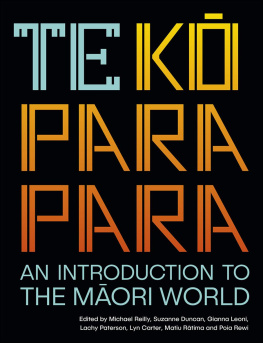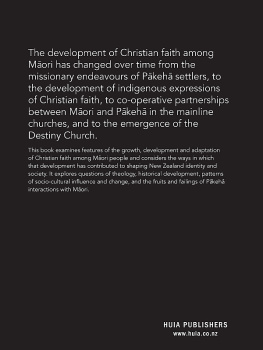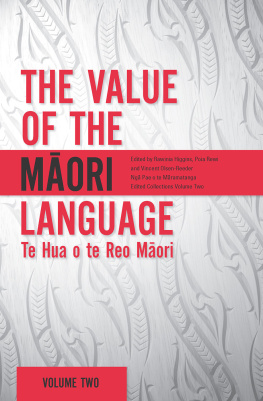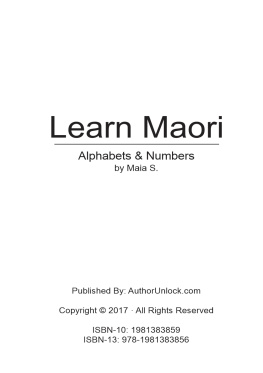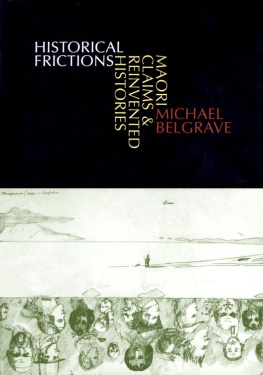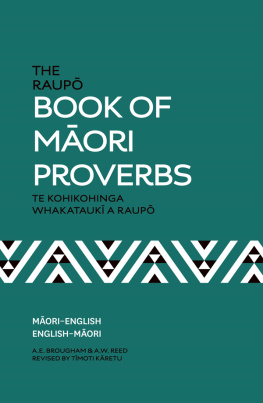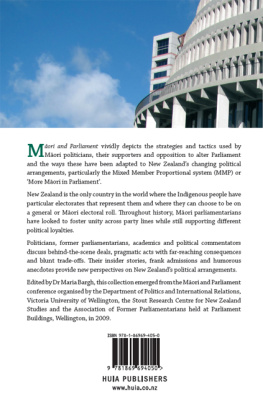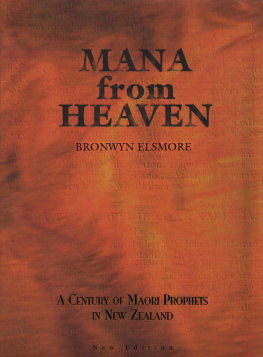TE KPARAPARA
An Introduction to the Mori World
Edited by Michael Reilly, Suzanne Duncan, Gianna Leoni, Lachy Paterson, Lyn Carter, Matiu Rtima and Poia Rewi
For Ginny Sullivan, an exemplary editor
I te tangi a te kparapara ki te taringa,
ko aua kupu ki te kamo.
Kpara e
Kia te tikanga
Kia te kawa
Kia te ritenga
E ringi nei i te atat
E tiu nei i te r
E k nei i te kkarauritanga
Ko Te Kparapara tnei e ktui nei i ng krero i te whenua me te rangi; i namata ki te ake ake; kia kawea e te ihirangi ng whakaaro, ng ritenga, ng wheako o te ao ki ng tai tuatawhiti.
Kua huri te ao, kua mau ia te tangi o tana waiata, engari, ko ng whiti ia, he whakaatu i ng aranga me ng tnga hou o te r, he whakaatu i te moe tahitanga o ng iwi maha me rtou tikanga ki te Mori.
N reira, whakarongo ki te waiata hou a Te Kparapara he hononga kaupapa o te w.
K, k.
E ko koe ia e ara e
Oh Bellbird
Let your voice ring out cultural etiquette
Let it sing out its customary practices
Let it call out the ritual expectations
Share your melody from dawn to dusk.
Hark, it is Te Kparapara that transcends earth and sky, physical and spiritual, from the past through to the future, practices and experiences across vast worlds.
The world evolves, but the chorus remains. Each verse here is repositioned with new insights and viewpoints, where ethnicities and cultures have merged with those of Mori.
Lend your ear to the revised perspectives presented here in Te Kparapara.
Let the music rise and its harmonies radiate.
E Tiu, Whakamihia: Acknowledgements
Any work is the product of many hands, often hidden from view. Here we wish to acknowledge those who helped bring Te Kparapara into the light of day. Each of our chapters was evaluated by one or more readers, scholars who agreed to comment on their colleagues work, despite their own often challenging work pressures. We thank you all: Peter Adds, Gipsi Foster, Rwinia Higgins, Hirini Kaa, Danny Keenan, Te Kani Kngi, Nathan Matthews, Jane McRae, Pita Meihana, Ocean Mercier, Angela Middleton, Te Tuhi Robust, Diane Rwhiu, Michael Stevens, Angela Wanhalla and Paerau Warbrick. We also thank other Otago colleagues who readily agreed to assist this project in various ways, including Erica Newman, Richard Walter and especially Les ONeill who drew the maps. The Division of Humanities at the University of Otago kindly funded Gianna Leoni to act as a research assistant for this project through a Humanities Research Grant.
Finally, we acknowledge and thank Auckland University Press, particularly its publisher, Sam Elworthy, and his expert team, especially Katharina Bauer, and the copy editor, Ginny Sullivan, for their consistent support and enthusiasm for this project from its beginnings. They have made the task of writing and editing this volume far easier and more enjoyable than it might otherwise have been. Thanks also to proofreaders Jane McRae and Louisa Kasza, indexer Carol Dawber, and to Katrina Duncan for her visionary layout and design of the book.
E Tiu, Whia:
An Introductory Note
Michael Reilly
Ka rite te kpara e k nei i te ata.
It is like a bellbird singing at dawn.
Birds hold a special place in the natural and cultural worlds of the Mori people of Aotearoa New Zealand. They were created by Tne-mahuta, an important spirit being responsible for forests and birds. Birds were considered the elder relations of people. Their ability to communicate meant the tangata whenua (indigenous people of the land) listened to them carefully, considering them to be messengers associated with the spirit world, and able to convey warnings or predictions to people. What they ate and the time of their appearance also guided Mori on the seasonal readiness of natural resources.
The kpara (bellbird) is particularly esteemed for the clarity and sweetness of its song; its loud dawn chorus, ushering in the light (te ao), betokened life and success. In the wisdom saying which begins this chapter, the kpara is a metaphor for the beautiful voice of the singer or speaker. Such exponents of the oral arts are highly esteemed in their communities and are called manu krero (talking birds).
When Mori people embraced the opportunities provided by literacy during the nineteenth century, they quickly took up the new technologies of the era, Like exponents of the oral arts, these newspapers enabled the voice of Mori to be heard: the clear, loud song of the bellbird piercing the cacophonous sounds of the more dominant colonisers.
By choosing the kpara to open our book, we wish to link our words to that ancestral oral world in which birds stood for the human capacity to create and to communicate their ideas, arguments and findings to an audience. Just as Te Kopara reached a wider New Zealand audience through the print medium, we hope this book will reach out and communicate with a diverse range of audiences: Mori communities that are now spread far and near, even beyond the expanse of Te Moana-nui-a-Kiwa (Pacific Ocean), and other peoples who wish to learn about the Mori world, such as those tauiwi (strangers, foreign people, non-Mori, immigrants) who have come to live in these southern Pacific islands we now call Aotearoa New Zealand.
Many of the editors and authors of these words live in a particular place, tepoti (Dunedin), in Te Waipounamu, also known as the South Island, which lies under the mana (authority) of the people of this land, Ki Tahu, also called Ngi Tahu. Mori who live in the southern parts of Te Waipounamu historically called the bellbird te kparapara, and we have chosen this local version of the birds name for the books title to acknowledge the people of this place. It also reflects our desire to draw on southern Mori knowledge and language throughout this book, complementing the often better-known stories and scholarship concerning northern Mori descent groups in Te Ika-a-Mui (North Island).
The kparapara links us to the poetical genius of Mori speakers and singers. In this book we have sought to incorporate within our more mundane prose narratives the compositions of generations of Mori artists down to the present, by quoting from songs, poems, speeches, wisdom-sayings and other works that collectively form the high talk of Maori oral tradition. These works reflect the beauty of the Mori language and enable authors to support and enhance their words by drawing on these pieces of artistry as an appropriate knaki (complement, condiment), just as a well-chosen song concludes whaikrero (Mori oratory).
The book, Te Kparapara, describes the past, present and possible future of Mori society from an indigenous point of view. Its scope and presentation reflect our experiences as teachers in Mori Studies at New Zealands oldest university, the University of Otago, where we seek to explain the complexities of the Mori world to a large and heterogeneous body of students, both indigenous and non-indigenous, drawn from the four corners of the globe.
To understand this complex world fully, we have divided Te Kparapara into three parts. In the first part, He Tumu: Foundations, we explore the deeper meanings of selected cultural ideas and practices, upon which other aspects of Mori society are built. Chapters in

